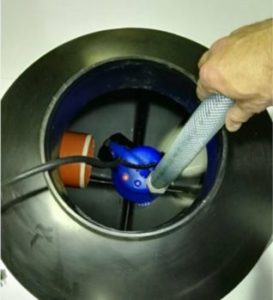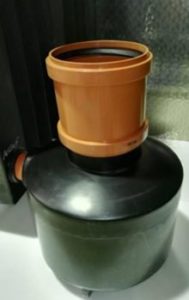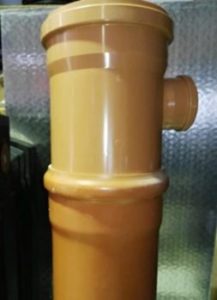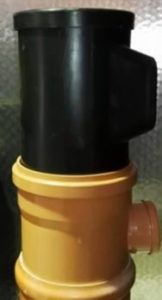The ClearFox® Pump Shaft
[vc_row height=”small” color_scheme=”alternate” us_bg_image_source=”featured” us_bg_overlay_color=”rgba(43,44,54,0.65)”][vc_column width=”2/3″][us_post_title align=”center” tag=”h1″][us_separator][vc_column_text]
If there is no gradient to the discharge point, the ClearFox® Nature unfortunately cannot be operated completely without current.
For this reason, the PPU team has thought about this and developed the ClearFox® pump shaft, which is documented in the appendix and rotated in one piece.
In addition to the pump sump, this also contains a distributor head through which the pump can be easily serviced. Additional components may be required on site.
[/vc_column_text][/vc_column][vc_column width=”1/3″][vc_column_text]
GET IN CONTACT NOW
[/vc_column_text][us_cform items=”%5B%7B%22type%22%3A%22text%22%2C%22inputmode%22%3A%22text%22%2C%22date_format%22%3A%22d%20MM%20yy%22%2C%22placeholder%22%3A%22Name%22%2C%22cols%22%3A%221%22%7D%2C%7B%22type%22%3A%22email%22%2C%22inputmode%22%3A%22text%22%2C%22date_format%22%3A%22d%20MM%20yy%22%2C%22placeholder%22%3A%22Email%22%2C%22cols%22%3A%221%22%7D%2C%7B%22type%22%3A%22textarea%22%2C%22inputmode%22%3A%22text%22%2C%22date_format%22%3A%22d%20MM%20yy%22%2C%22placeholder%22%3A%22Text%22%2C%22cols%22%3A%221%22%7D%2C%7B%22type%22%3A%22agreement%22%2C%22inputmode%22%3A%22text%22%2C%22date_format%22%3A%22d%20MM%20yy%22%2C%22value%22%3A%22You%20agree%20that%20your%20data%20may%20be%20used%20to%20process%20your%20request.%20Further%20information%20and%20revocation%20instructions%20can%20be%20found%20in%20the%20%3Ca%20href%3D%5C%22https%3A%2F%2Fstage.clearfox.com%2Fprivacy-policy%2F%5C%22%20target%3D%5C%22_blank%5C%22%20rel%3D%5C%22noopener%5C%22%3Eprivacy%20policy%3C%2Fa%3E.%20%22%2C%22cols%22%3A%221%22%7D%5D” button_text=”Send” receiver_email=”info@stage.clearfox.com”][/vc_column][/vc_row][vc_row height=”small”][vc_column width=”1/2″][us_image image=”18724″][/vc_column][vc_column width=”1/2″][vc_column_text]
The complete pump shaft set consists of:
– 1 x pump sump (= sampling) DN550
– 1 x distribution head with cover DN250
Optional:
– 1 x 230VAC submersible pump with vertical float switch
– Extension set for discharge class D
Legend drawing pump shaft:
– 1. inlet DN100 (Øa=110mm) (Mat. KG/PE)
– 2. drain for pump hose DN100 (Øa=110mm) (Mat. KG/PE) to be laid with slope away from the system!
– 3. aeration pipe DN100 (Øa=110mm) (Mat. KG / PE) If the aeration pipe is laterally distorted in the floor, always with a slope towards the system!
– 4. aeration pipe DN100 (Øa=110mm) (Mat. KG / PE) If the aeration pipe in the floor is laterally distorted, always with a slope to the system!
– 5. pump sump DN550
– 6. alarm transmitter (indicator for water backwater)
– 7. distributor head with cover DN250
– 8. air scoop[/vc_column_text][/vc_column][/vc_row][vc_row height=”small”][vc_column width=”1/2″][vc_column_text]
Accessories required on site (additionally marked in blue):
– Z1: Inlet pipe DN 100 (Øa=110mm) (Mat. KG/PE)
– Z2: Ventilation pipe DN 100 (optional for winter version) (Øa=110mm) (Mat. KG/PE)
– Z3: Dome extension (option sliding dome, or Wavin)
– Z4: Dome extension (option sliding dome, or Wavin)
– Z5: Vent pipe DN 100 (Øa=110mm) (Mat. KG/PE)
– Z6: Branch DN 250/100 (Mat. KG/PE)
– Z7: Pipe extension DN 250 (Øa=250mm) (Mat. KG/PE)
– Z8: Drain pipe DN 100 (Øa=110mm) (Mat. KG/PE) with slope away from the system! (There must be no backwater to the system!)
– Z9: Sliding sleeve DN250[/vc_column_text][/vc_column][vc_column width=”1/2″][us_image image=”18726″][/vc_column][/vc_row][vc_row height=”small”][vc_column width=”1/2″][us_image image=”18728″ size=”us_600_400″][/vc_column][vc_column width=”1/2″][vc_column_text]
Legend Pump chamber side view:
– 1. pump sump DN550
– 2. distributor head with cover DN250
Accessories required on site (marked blue):
– Z1: DN250 sleeve (KG/PE)
– Z2: Pipe extension DN 250 (mat. KG/PE)
– Z3: branch DN 250/100 (mat. KG/PE)
– Z4: Drain pipe DN 100 (Øa=110mm) (Mat. KG/PE) with slope away from the system![/vc_column_text][/vc_column][/vc_row][vc_row height=”small”][vc_column width=”1/2″][vc_column_text]
Legend Pump chamber side view:
– 1. pump sump DN550
– 2. distributor head with cover DN250
Accessories required on site (marked blue):
– Z1: DN250 sleeve (KG/PE)
– Z2: Pipe extension DN 250 (mat. KG/PE)
– Z3: branch DN 250/100 (mat. KG/PE)
– Z4: Drain pipe DN 100 (Øa=110mm) (Mat. KG/PE) with slope away from the system![/vc_column_text][/vc_column][vc_column width=”1/2″][vc_column_text]Downloads:
♦ Pump shaft[/vc_column_text][/vc_column][/vc_row][vc_row height=”small”][vc_column][vc_tta_accordion][vc_tta_section title=”Read More About Installation Process of ClearFox® Pump shaft” el_id=”1616497059993-48d0f672-fb200a3f-f2aa”][vc_column_text]
Instructions for the small wastewater treatment plant with pump option
A: Push the pump shaft into the marked outlet of the
B: Biomodule (DN100 socket connection). (Please pay attention to the existing socket seals).
C: Hose nozzle suitable for ¾” hose
D: Adapter sleeve
E: Non-return valve – if the outlet of the hose is in an area that is not frost-proof, the rubber valve must be pinched out to ensure that the hose runs empty. This prevents the hose from freezing.
The sump pump
A pump with an associated pump shaft, also known as a lifting unit, is required if the outlet and the discharge point are at different heights.
The pump shaft can bridge heights of up to seven metres.
Since pump shaft are usually used in the clear water area of the sewage treatment plant and no aggressive wastewater can damage the pump, the pumps we use have a long service life and are largely trouble-free. In addition, the pumps we use, e.g. mammoth pumps, are extremely low-maintenance, trouble-free and durable.
It can be said that the maintenance costs of pump shafts in the clear water sector are extremely low.
It should be noted that the electricity costs are almost negligible, as they amount to only about €1 per inhabitant equivalent per year.
Here is an example calculation:
Using the following example, you can see the costs that arise when, for example, 2.5 metres in height have to be overcome with the help of our lifting unit:
The average water consumption of a German citizen is 125 litres per day (= equivalent to the number of inhabitants).
| 0.125m³ x 365days | =45.625m³ water consumption per capita and year | |
| 45.625m³ annual water consumption / 8h pump capacity | =5.70h pump running time per year | |
| 5,70h x 0,55KW/h | =3,14KW | |
| 3,14KW x ca 30 €uro Cent (assumed electricity price) | =0,94€uro | |
 As you can see, the calculated electricity costs in this cost comparison, assuming an electricity price of 30 cents per kilowatt hour and inhabitant, are less than one euro.
As you can see, the calculated electricity costs in this cost comparison, assuming an electricity price of 30 cents per kilowatt hour and inhabitant, are less than one euro.
In addition to all technical small wastewater treatment plants from ClearFox® and other manufacturers, it is also possible to connect the ClearFox® pump shaft to all wastewater treatment plants with a DN100 outlet. Even in the case of small sewage treatment plants operated without electricity, it may be necessary to install a pump shaft due to the lack of a gradient to the discharge point.
This does not interfere with the wastewater treatment of the treatment plant, but merely raises the treated water to the desired level. Maintenance of the pump sump is child’s play. If you notice that a coating has formed on the bottom or solids have settled, you can easily hose them off with the help of a garden hose. No further maintenance is required.
ClearFox® wastewater pumps generally do not have fin floats.
Since fin float pumps are controlled by moving cables, cable breaks can occur with these pumps.
Therefore, we only use dirty water pumps with integrated, horizontal float switches. These have proven themselves over the years thanks to their reliability. This link will take you to the data sheet of the pump we use for small sewage treatment plants.

Pump accessory (to be provided by customer):
F: Hose for drain (to be provided by customer), suitable for ¾ inch hose.
G: The hose must be secured with a suitable VA hose clamp! The hose must then be connected to the power cable with cable ties and lashed tightly together. This is then secured in the upper area of the distributor head.
 H: Insert the pump centrally in the pump shaft. Lead the hose and cable out at the top. This can also be done after the finished pump shaft has been completely installed, or the pump can be inserted from above.
H: Insert the pump centrally in the pump shaft. Lead the hose and cable out at the top. This can also be done after the finished pump shaft has been completely installed, or the pump can be inserted from above.

I: Push the DN 250 sleeve onto the pump shaft. Guide the hose and cable upwards.
 J: Insert the DN 250 pipe extension into the sleeve. According to the required total height of the pump shaft, to the upper edge of the ground.
J: Insert the DN 250 pipe extension into the sleeve. According to the required total height of the pump shaft, to the upper edge of the ground.

K: Insert DN 250 branch.
L: Lay the outlet with a DN 100 pipe. Guide the pump hose sideways through the pipe to the outlet. Lead the cable further upwards.
The outgoing DN 100 outlet pipe must be laid with a gradient away from the system ! There must be no backwater!

M: Insert the distributor head with cover. The cover should be flush with the upper edge of the ground. The hose is to be connected via the angle connector inside (see installation drawing).
N: Fasten the cable guide in the slitter recess so that it is possible to pull the pump. Guide the earthed plug outwards to the socket (Caution! If the connecting cable of the pump is not long enough, observe the VDE when extending it).
[/vc_column_text][/vc_tta_section][/vc_tta_accordion][/vc_column][/vc_row][vc_row color_scheme=”primary”][vc_column][us_cta title=”Speak to one of our team today” controls=”bottom” btn_label=”contact us now” btn_link=”url:https%3A%2F%2Fstage.clearfox.com%2Fcontact%2F|title:Contact”][/us_cta][/vc_column][/vc_row]